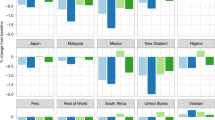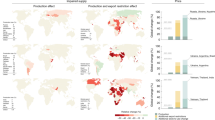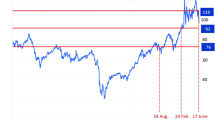Abstract
The Russia–Ukraine conflict reduced global wheat supplies, yet the food security implications vary across countries. We identify a 39% decrease in Ukrainian wheat exports in 2022 resulting in >70% import losses in some of the countries most vulnerable to these disruptions, with substantial impacts felt in Egypt, Oman, Saudi Arabia, Libya, Mauritania, Yemen and Lebanon. Differential impacts are a function of access to capital and international trade, suggesting the need for policy measures to defuse the impending food crisis.
This is a preview of subscription content, access via your institution
Access options
Access Nature and 54 other Nature Portfolio journals
Get Nature+, our best-value online-access subscription
$29.99 / 30 days
cancel any time
Subscribe to this journal
Receive 12 digital issues and online access to articles
$119.00 per year
only $9.92 per issue
Buy this article
- Purchase on Springer Link
- Instant access to full article PDF
Prices may be subject to local taxes which are calculated during checkout


Similar content being viewed by others
Data availability
All data generated in this study are available at https://doi.org/10.5281/zenodo.7826603. Raw data can be obtained from the Statistics Division of the United Nations (https://comtradeplus.un.org/), the United Nations Food and Agriculture Organization (https://www.fao.org/faostat/en/#data/FBS), the United States Department of Agriculture (https://apps.fas.usda.gov/psdonline/app/index.html#/app/downloads).
Code availability
Data analysis was carried out using R v.4.1.0. and the following packages: tidyverse (v. 1.3.2), ggplot2 (v. 3.4.0) and circlize (v. 0.4.15), all of which are publicly available at no cost at https://www.r-project.org. The code developed to generate the figures is available at https://doi.org/10.5281/zenodo.7826603.
References
D’Odorico, P., Carr, J. A., Laio, F., Ridolfi, L. & Vandoni, S. Feeding humanity through global food trade. Earths Future 2, 458–469 (2014).
Bentley, A. World view. Nature 603, 551 (2022).
Karakoc, D. B. & Konar, M. A complex network framework for the efficiency and resilience trade-off in global food trade. Environ. Res. Lett. 16, 105003 (2021).
Carriquiry, M., Dumortier, J. & Elobeid, A. Trade scenarios compensating for halted wheat and maize exports from Russia and Ukraine increase carbon emissions without easing food insecurity. Nat. Food 3, 847–850 (2022).
Hellegers, P. Food security vulnerability due to trade dependencies on Russia and Ukraine. Food Secur. 14, 1503–1510 (2022).
Behnassi, M. & El Haiba, M. Implications of the Russia–Ukraine war for global food security. Nat. Hum. Behav. 6, 754–755 (2022).
Lin, F. et al. The impact of Russia–Ukraine conflict on global food security. Glob. Food Sec. 36, 100661 (2023).
Abay, K. A., et al. The Russia–Ukraine Crisis: Implications for Global and Regional Food Security and Potential Policy Responses vol. 39 (Intl Food Policy Res Inst, 2022).
Ahn, S., Kim, D. & Steinbach, S. The impact of the Russian invasion of Ukraine on grain and oilseed trade. Agribusiness 39, 291–299 (2023).
Burkholz, R. & Schweitzer, F. International crop trade networks: the impact of shocks and cascades. Environ. Res. Lett. 14, 114013 (2019).
Marchand, P. Reserves and trade jointly determine exposure to food supply shocks. Environ. Res. Lett. 11, 095009 (2016).
New IDA Grant to Preserve Food Security and Protect Livelihoods in Yemen (World Bank, 2021); https://www.worldbank.org/en/news/press-release/2021/05/11/us-127-million-aims-to-lessen-impacts-of-covid-19-and-conflict-on-rural-yemenis
New World Bank Project Addresses Food Security Challenges in Tunisia (World Bank, 2022); https://www.worldbank.org/en/news/press-release/2022/06/28/new-world-bank-project-addresses-food-security-challenges-in-tunisia
Lebanon, Middle East and North Africa: Wheat Supply Emergency Response Project-Procurement Plan. Project P178866 (World Bank, 2022).
Egypt, Middle East and North Africa: Emergency Food Security and Resilience Support Project. Project P178926 (World Bank, 2022).
Annual Country Reports—Libya (World Food Program, 2022); https://www.wfp.org/publications/annual-country-reports-libya
Hunger Hotspots: FAO-WFP Early Warnings on Acute Food Insecurity (August to November 2021 Outlook) (FAO/WFP, 2021).
Islamic Republic of Mauritania 2022 Article IV Consultation and Request for 42-Month Arrangements Under the Extended Credit Facility and the Extended Fund Facility-Press Release; Staff Report; and Statement by the Executive Director for the Islamic Republic of Mauritania, Vol. 2023 (International Monetary Fund, 2023).
Osendarp, S. et al. Act now before Ukraine war plunges millions into malnutrition. Nature 604, 620–624 (2022).
India Rice: Production Revised to Record Levels Due to Larger Rabi Crop (USDA, 2023).
Glauber, J., Laborde, D., & Mamun, A. From bad to worse: How Russia–Ukraine war-related export restrictions exacerbate global food insecurity. IFPRI Blog Series: High Food/Fertiliser Prices and War in Ukraine (2022); https://www.ifpri.org/blog/bad-worse-how-export-restrictions-exacerbate-global-food-security
Acknowledgements
Funding from the National Science Foundation award EAR 2142967 (to M.F.M.) and from the Environmental Change Initiative at the University of Notre Dame (to L.B.) is gratefully acknowledged.
Author information
Authors and Affiliations
Contributions
M.F.M. and L.B. designed the research; L.B. and M.F.M performed the analysis; M.F.M., L.B. and P.W. wrote the paper.
Corresponding author
Ethics declarations
Competing interests
The authors declare no competing interests.
Peer review
Peer review information
Nature Food thanks Tanaka Tetsuji and the other, anonymous, reviewer(s) for their contribution to the peer review of this work.
Additional information
Publisher’s note Springer Nature remains neutral with regard to jurisdictional claims in published maps and institutional affiliations.
Supplementary information
Supplementary Information
Supplementary Methods and Supplementary Figs. 1 and 2.
Supplementary Table 1
Correction for unreported exports in 2022.
Supplementary Table 2
Countries included (‘x’) in each dataset: 119 countries were included in all three datasets and included in the analysis.
Rights and permissions
Springer Nature or its licensor (e.g. a society or other partner) holds exclusive rights to this article under a publishing agreement with the author(s) or other rightsholder(s); author self-archiving of the accepted manuscript version of this article is solely governed by the terms of such publishing agreement and applicable law.
About this article
Cite this article
Bertassello, L., Winters, P. & Müller, M.F. Access to global wheat reserves determines country-level vulnerability to conflict-induced Ukrainian wheat supply disruption. Nat Food 4, 673–676 (2023). https://doi.org/10.1038/s43016-023-00806-w
Received:
Accepted:
Published:
Issue Date:
DOI: https://doi.org/10.1038/s43016-023-00806-w
This article is cited by
-
Wheat trade in times of war and peace
Nature Food (2023)



